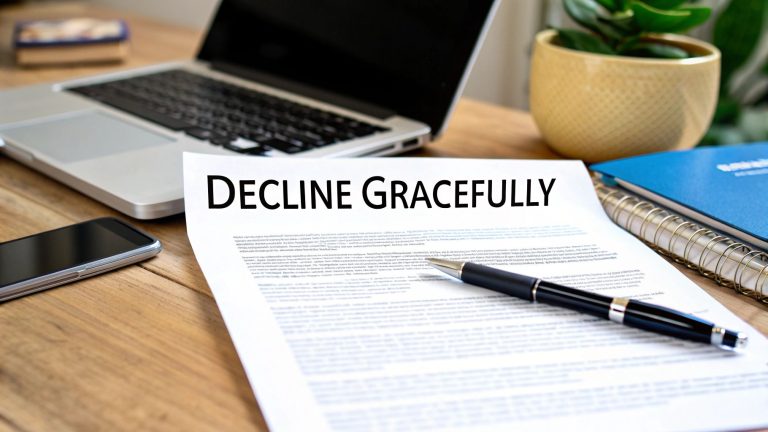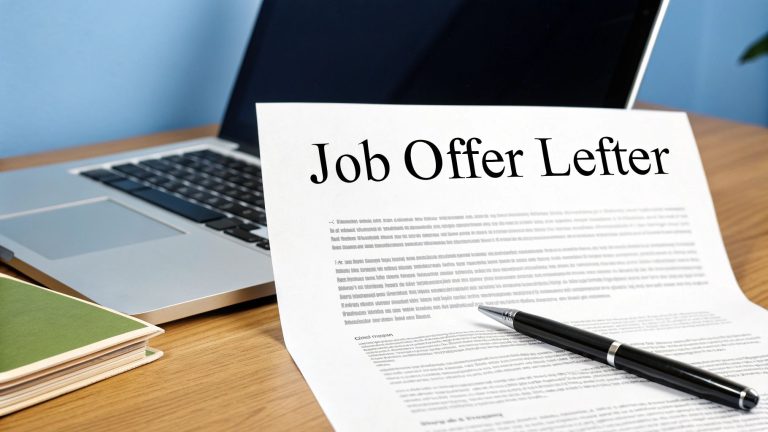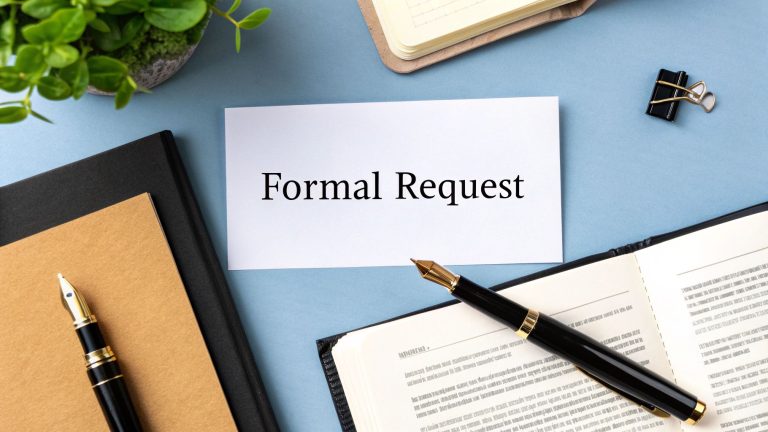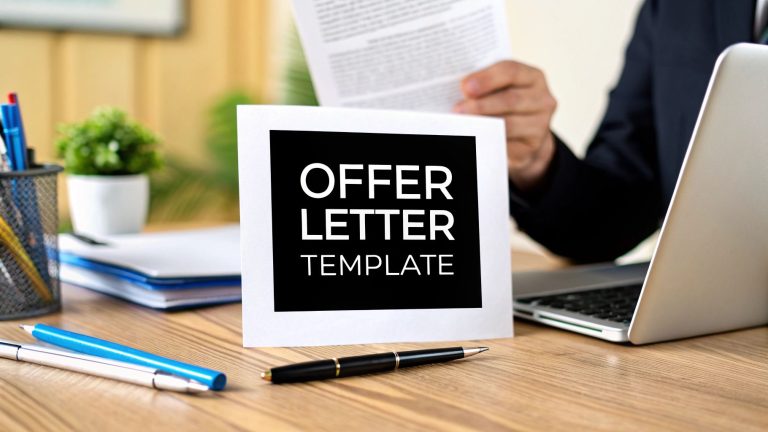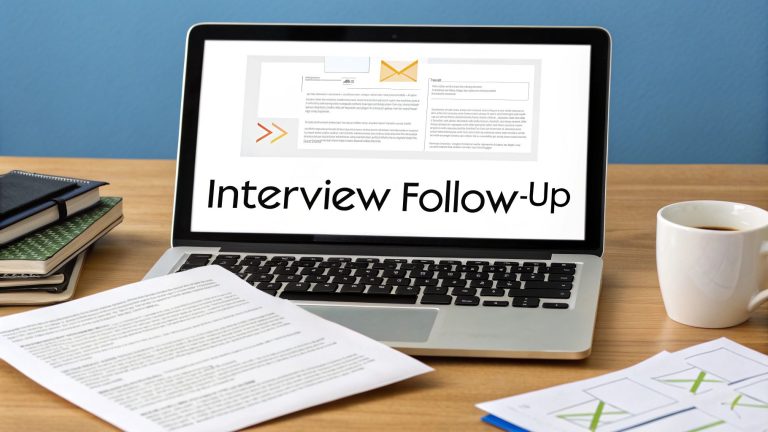A well-crafted business proposal is more than just a document; it's a strategic tool that can unlock new projects, secure crucial funding, and forge powerful partnerships. But with so many different scenarios, how do you write one that gets a resounding 'yes'? This guide moves beyond theory to provide actionable business proposal letter samples you can adapt and use immediately.
We will dissect seven distinct proposal types, each with a detailed breakdown of its structure, tone, and strategic purpose. You'll learn not just what to write, but why certain approaches work, empowering you to create compelling letters for any situation. A persuasive proposal starts by clearly articulating the client's pain points. Therefore, mastering the art of writing effective problem statements is a foundational skill that sets the stage for your solution.
From formal solicited bids and creative unsolicited pitches to internal project requests and critical grant applications, this collection gives you the blueprints needed to turn your ideas into approved realities. Each example is designed to provide replicable tactics and key takeaways, so you can confidently build a proposal that stands out and wins. Let's dive into the samples that will help you secure your next opportunity.
1. Solicited Business Proposal Letter
A solicited business proposal letter is a direct response to a specific request from a potential client. This request often comes in the form of a Request for Proposal (RFP), Request for Quote (RFQ), or a direct inquiry. Because the client initiated the contact, this is considered a "warm" lead, giving you a significant advantage. Your primary goal is to prove you've listened carefully and are the best choice to meet their explicitly stated needs.
Strategic Breakdown
The key to a winning solicited proposal is demonstrating compliance and understanding. You aren't just selling your services; you are providing a direct solution to a problem the client has already defined. For instance, a construction firm bidding on a project isn't just showing its building expertise; it's showing how it will meet the exact architectural specifications, timeline, and budget outlined in the RFP.
This approach is about precision. Every claim you make should tie back to a requirement in the client's original request. Among the many business proposal letter samples you might study, the solicited format is the most structured and direct.
Key Takeaway: The foundation of a strong solicited proposal is mirroring the client's request. Your document should be a direct, point-by-point answer to their needs, making it easy for them to see you are the right partner.
Actionable Tips for Success
- Reference the Request: Immediately mention the RFP or request number and date in your introduction. This shows professionalism and helps the client categorize your document.
- Create a Compliance Matrix: For complex RFPs, include a table or checklist that explicitly maps each of their requirements to the section in your proposal where you address it.
- Address Evaluation Criteria: Structure your proposal around the client's stated evaluation criteria. If they prioritize experience, lead with case studies. If cost is key, make your pricing section exceptionally clear.
The following infographic illustrates the core workflow for creating a powerful solicited proposal.
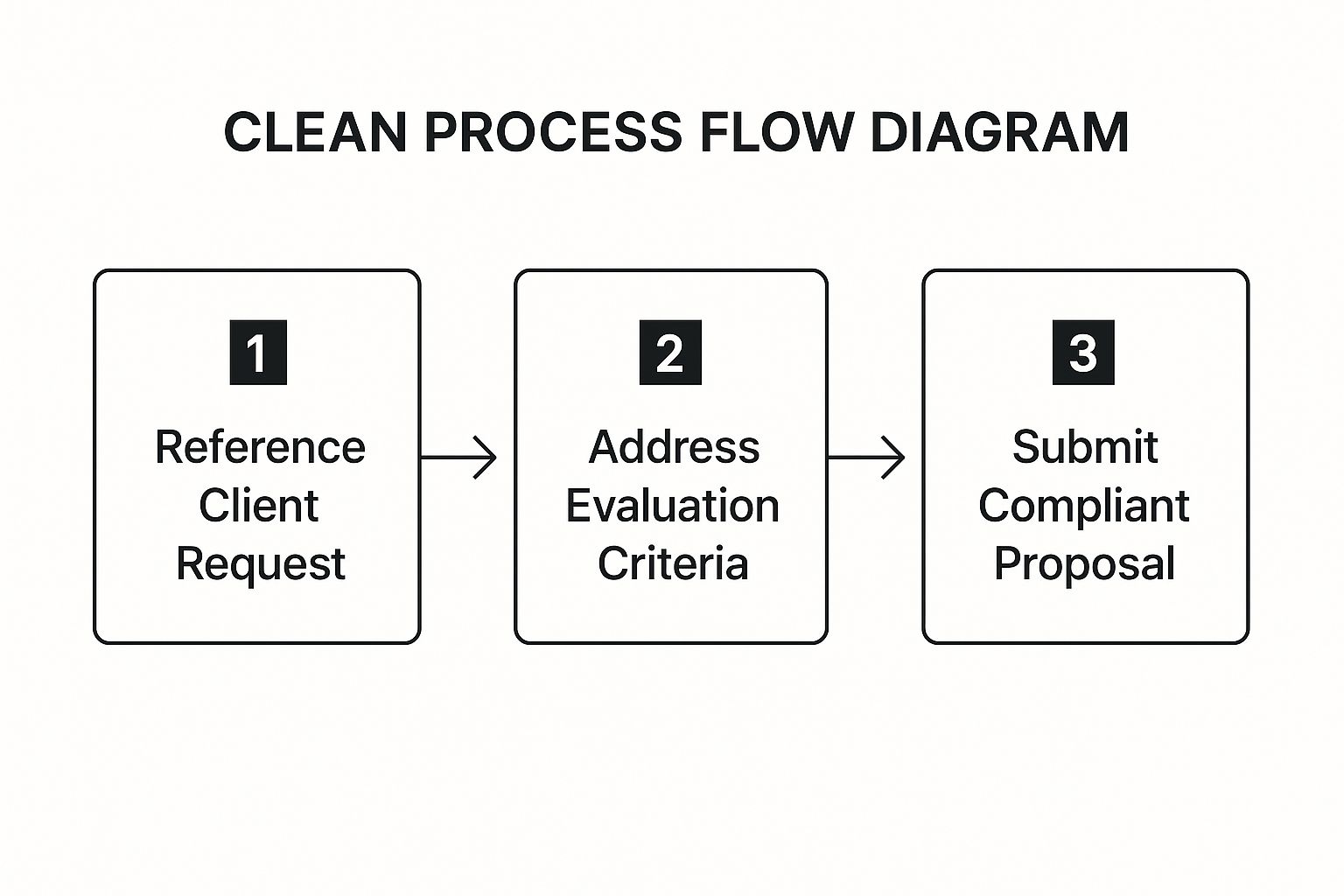
This process flow emphasizes that every step must directly link back to the client's initial request to ensure your final submission is fully compliant and persuasive.
2. Unsolicited Business Proposal Letter
An unsolicited business proposal letter is a proactive outreach document sent to potential clients who have not requested information about your services. This "cold" approach identifies a problem or opportunity the recipient may not have recognized and presents your solution. Because there is no existing relationship, this strategy requires exceptional research and a crystal-clear value proposition to capture attention and generate interest from scratch.

Strategic Breakdown
The core of a successful unsolicited proposal is shifting the prospect's perspective. You are not just selling a service; you are introducing a new, valuable idea. For example, a digital marketing agency doesn't just offer SEO; it presents a data-backed analysis showing a competitor is capturing 40% more local search traffic and then outlines a plan to close that gap. This method transforms a cold pitch into a strategic consultation.
This approach is about relevance and insight. Your proposal must immediately demonstrate that you understand the prospect's business and have identified a tangible opportunity. Among the various business proposal letter samples, the unsolicited format demands the most creativity and strategic thinking to break through the noise. For practical application, exploring proven cold email templates for sales proposals can provide a strong foundation for your unsolicited outreach.
Key Takeaway: A compelling unsolicited proposal creates demand by diagnosing a hidden problem or revealing an unseen opportunity. Success hinges on deep personalization and proving your value before you are asked.
Actionable Tips for Success
- Lead with an Insight: Start with a specific, data-driven observation about their company, market, or a competitor. This proves you've done your homework.
- Personalize Beyond the Name: Reference a recent company achievement, a new product launch, or a quote from their CEO. Show that your message is for them and them alone.
- Focus on One Core Idea: Avoid overwhelming them with a full menu of services. Present a single, high-impact solution to the problem you identified and make your call-to-action a simple, low-commitment next step.
To master this format, you can find more guidance on how to write an effective unsolicited business proposal letter.
3. Partnership or Joint Venture Proposal Letter
A partnership proposal letter is a formal document designed to initiate a collaborative relationship between two or more organizations. Unlike a sales proposal, the goal isn't a simple transaction but the creation of a synergistic alliance where combined resources, market access, or expertise lead to mutual growth. It outlines how the entities can achieve goals that would be difficult or impossible to reach alone.
Strategic Breakdown
The core of a successful partnership proposal is demonstrating a "win-win" scenario. It must clearly articulate the value proposition for both parties. For example, the historic partnership between Starbucks and Barnes & Noble wasn't just about selling coffee; it was about creating an enhanced in-store experience that encouraged customers to stay longer, browse more, and purchase both books and beverages.
This approach requires deep research into your potential partner’s strategic objectives and pain points. Your proposal must present a compelling case for how your strengths directly address their needs or unlock new opportunities for them. This makes it more of a strategic document than a simple sales letter and requires a different level of detail than many other business proposal letter samples.
Key Takeaway: A partnership proposal must be built on mutual benefit. Frame your offer not as what you want from them, but as a shared opportunity to create value that neither organization could generate on its own.
Actionable Tips for Success
- Quantify the Value: Don't just state that the partnership will be beneficial. Use data, market research, and financial projections to show the potential return on investment for both sides.
- Address Potential Concerns: Proactively discuss potential risks, such as brand dilution or operational conflicts, and propose clear solutions or governance structures to mitigate them.
- Propose a Pilot Program: Suggest a smaller, limited-scope initial engagement or pilot project. This lowers the barrier to entry and allows both parties to test the collaboration with minimal risk.
Similar to this type of proposal, a letter of interest can also be used to explore potential collaborations. For those looking to initiate such discussions, you can learn more about how to craft an effective letter of interest.
4. Product or Service Sales Proposal Letter
A product or service sales proposal letter is crafted to persuade a potential customer to purchase specific offerings. It goes beyond a simple price quote by highlighting product features, tangible benefits, and competitive advantages, all while connecting directly to the customer's known pain points. This proposal type is laser-focused on demonstrating a clear return on investment (ROI) and building unshakable confidence in your solution.

Strategic Breakdown
The core strategy here is to shift the conversation from cost to value. Instead of just listing what your product does, you must illustrate what it achieves for the client. For instance, a cloud storage provider like Dropbox wouldn't just sell "10TB of storage"; it would propose a solution for "streamlining cross-departmental collaboration and securing critical company assets," directly addressing enterprise-level challenges.
This approach is about creating a compelling business case. Your proposal should make the decision to buy feel not just logical, but necessary. Among the various business proposal letter samples available, this format is the most persuasive and benefit-driven, turning a simple sales pitch into an indispensable solution.
Key Takeaway: Lead with the customer's desired outcome, not your product's features. Frame your offering as the most direct and effective path to solving their specific problem or achieving their goals.
Actionable Tips for Success
- Quantify the Value: Use specific numbers and metrics to demonstrate ROI. For example, "Our software reduces administrative tasks by 15 hours per week, saving you an estimated $25,000 annually."
- Offer Tiered Options: Present two or three pricing packages (e.g., Basic, Pro, Enterprise) to accommodate different budgets and needs. This gives the client a sense of control and often encourages them to select a mid-tier option over a simple yes/no decision.
- Include Social Proof: Build credibility by incorporating client testimonials, case study snippets, and logos of well-known customers. This reassures prospects that others have trusted you and found success.
For a deeper dive into crafting compelling sales correspondence, you can learn more about professional letter writing techniques. The video below also offers valuable insights into structuring a winning sales proposal.
By focusing on client outcomes and providing concrete proof, your sales proposal becomes a powerful tool for closing deals.
5. Grant or Funding Proposal Letter
A grant or funding proposal letter is a formal request for financial support directed at foundations, government agencies, or corporate philanthropies. Unlike a typical sales proposal, its primary purpose is not commercial profit but to secure funding for a project that addresses a specific social, scientific, or community need. The proposal must articulate a clear problem, a credible solution, and the applying organization's capacity to deliver measurable results.
Strategic Breakdown
The core strategy behind a successful grant proposal is mission alignment. You are not just asking for money; you are proposing a partnership to achieve a shared goal. For instance, a nonprofit seeking funds for a local literacy program must demonstrate how its project directly advances the specific educational mission of the target foundation. Every element, from the budget to the project timeline, must be framed to resonate with the funder’s stated priorities and values.
This approach demands meticulous research and precision. Among the various business proposal letter samples available, the grant format is the most rigorous, requiring a compelling narrative backed by hard data and evidence of need. Your proposal must prove that your initiative is a sound social investment.
Key Takeaway: The foundation of a winning grant proposal is demonstrating a direct and powerful alignment with the funder's mission. Your document must convince them that by funding you, they are effectively advancing their own organizational goals.
Actionable Tips for Success
- Mirror Funder Language: Scrutinize the funder's website, annual reports, and past funded projects. Use their specific terminology and keywords in your proposal to show you understand and share their vision.
- Lead with Impact: Begin with a powerful executive summary or letter of inquiry that clearly states the problem, your solution, and the requested funding amount. Make it easy for reviewers to grasp the core of your request immediately.
- Quantify Everything: Use data to validate the problem you are addressing and to define your expected outcomes. Instead of saying you will "help students," state that you will "improve reading proficiency by 15% for 200 third-grade students."
6. Internal Business proposal Letter
An internal business proposal letter is a formal document written to decision-makers within your own company. Its purpose is to advocate for a new initiative, a change in process, or the allocation of resources. Unlike external proposals that sell to clients, this type is about persuading your own leadership to invest time, money, or personnel in your idea.
Strategic Breakdown
The core of a successful internal proposal is aligning your idea with the company's existing strategic goals. You must demonstrate how your initiative helps solve an internal problem or capitalizes on an opportunity that benefits the entire organization. For example, an IT department proposing a cloud migration isn't just suggesting a technology change; it's making a business case for improved scalability, long-term cost savings, and enhanced data security, all of which are top-level executive concerns.
This approach requires a deep understanding of organizational politics, budget cycles, and departmental pain points. When you review various business proposal letter samples, the internal format stands out for its focus on ROI, risk mitigation, and alignment with internal priorities rather than external market competition. Proper letter-writing etiquette is also crucial to maintain professionalism and respect for the chain of command.
Key Takeaway: Frame your proposal as a solution to a larger organizational challenge. Your idea should directly support stated company objectives, making it an easy "yes" for leadership.
Actionable Tips for Success
- Use Internal Data: Support your claims with company-specific metrics. Show how your proposal will improve efficiency, reduce costs, or increase revenue using data your leadership already trusts.
- Address Stakeholder Concerns: Anticipate and address potential objections from different departments (e.g., Finance, Operations, HR) directly in your proposal. This shows foresight and a collaborative mindset.
- Offer a Phased Approach: Propose a pilot program or a phased rollout to minimize initial risk and investment. This makes it easier for decision-makers to approve a smaller, proof-of-concept stage.
7. One-Page Business Proposal Letter
A one-page business proposal letter is a highly condensed, impactful document designed to present a compelling offer quickly. Its primary strength is its brevity, respecting the client's time while delivering all essential information in a single-page format. This approach is ideal for smaller projects, follow-up offers, or situations where a lengthy, formal proposal would be excessive.

This format forces you to be disciplined and focus only on what truly matters to the client. For instance, a freelance web developer might use a one-pager to propose adding a new e-commerce feature to an existing client's website, cutting straight to the problem, solution, cost, and timeline.
Strategic Breakdown
The strategy behind a one-page proposal is to eliminate friction and get to a "yes" faster. By removing fluff and concentrating on the core value proposition, you make it incredibly easy for a decision-maker to understand, approve, and act. The goal is not to overwhelm with details but to build confidence through clarity and directness.
This focused approach is about precision and persuasion. Every sentence must serve a purpose, whether it's identifying a pain point, presenting your solution, or outlining the next steps. When searching for business proposal letter samples, the one-page format demonstrates how to achieve maximum impact with minimal content.
Key Takeaway: A one-page proposal prioritizes clarity and action over exhaustive detail. Its power lies in making the decision-making process as simple as possible for the client by presenting a clear problem, a direct solution, and an obvious path forward.
Actionable Tips for Success
- Use Visual Structure: Employ headings, bullet points, and bold text to guide the reader’s eye through the document. White space is your friend; it prevents the page from looking cluttered.
- Focus on the "What" and "Why": Clearly state the client's problem ("What") and articulate why your solution is the best choice ("Why"). The "how" can be discussed later.
- Include a Clear Call-to-Action (CTA): End with a specific next step. For example, "To proceed, simply sign below and return" or "Click here to approve this proposal and schedule our kickoff call."
Comparison of 7 Business Proposal Letter Types
| Proposal Type | Implementation Complexity | Resource Requirements | Expected Outcomes | Ideal Use Cases | Key Advantages |
|---|---|---|---|---|---|
| Solicited Business Proposal | High – detailed, structured response | Significant time and documentation | Higher conversion due to client interest | Established businesses responding to formal RFPs | Clear client expectations, professionalism |
| Unsolicited Business Proposal | Medium – requires strong research | Extensive market research and personalization | Lower response rate but potential new relationships | Service providers proactively expanding client base | Opportunity creation, less competition |
| Partnership/Joint Venture Proposal | High – complex strategic alignment | Collaboration, negotiation, planning | Access to new markets, shared resources | Companies seeking strategic alliances or joint ventures | Shared risk and expertise, faster market entry |
| Product or Service Sales Proposal | Medium – moderately detailed | Product knowledge, pricing strategy | Direct revenue generation, measurable sales | B2B sales teams with defined products/services | Clear call-to-action, scalable templates |
| Grant or Funding Proposal | High – rigorous documentation | Detailed project planning, budgeting | Access to non-dilutive funding | Nonprofits, research institutions seeking funding | Validation of impact, enhanced credibility |
| Internal Business Proposal | Medium – requires understanding internal politics | Internal data, stakeholder engagement | Approval for new initiatives, resource allocation | Employees advocating organizational changes | Lower barriers, direct impact on company |
From Sample to Success: Your Next Steps in Proposal Writing
We’ve explored a wide range of business proposal letter samples, from solicited and unsolicited pitches to internal project requests and funding applications. Seeing these examples in action moves the concept of proposal writing from abstract theory to a practical, achievable skill. The goal was never to provide a template for you to copy and paste. Instead, the real value lies in deconstructing the strategic architecture behind each successful letter.
By analyzing these documents, you can see how the most persuasive proposals are not just well-written; they are meticulously structured. They anticipate the reader's questions, address potential objections before they arise, and build a logical bridge from the client’s problem to your proposed solution. This is the core principle that ties every effective proposal together.
Synthesizing the Core Strategies
As you move forward, remember the common threads that ran through each analysis. These are the foundational pillars of any proposal that commands attention and inspires action.
- Audience-Centricity is Non-Negotiable: The most critical takeaway is that your proposal is not about you, your company, or your service. It is about the recipient and their needs. Every section, from the introduction to the call to action, must be filtered through the lens of "What's in it for them?"
- Clarity Over Complexity: Jargon and overly technical language create barriers. The strongest proposals use simple, direct language to explain complex ideas, ensuring the value proposition is immediately understood by any stakeholder, regardless of their technical expertise.
- The Power of a Clear Problem Statement: Before you can present a solution, you must demonstrate a deep and empathetic understanding of the problem. A well-defined problem statement builds trust and validates the necessity of your proposed course of action.
- Action-Oriented Language Drives Decisions: Vague promises lead to indecision. Use strong verbs, specify clear deliverables, and outline a precise timeline. This approach transforms your proposal from a passive document into an active roadmap for success.
Your Action Plan for Crafting Winning Proposals
Viewing samples is the first step, but true mastery comes from application. Use the insights from this article to build a repeatable process for your own proposal writing.
- Start with Research, Not Writing: Before typing a single word, invest time in understanding your audience. Research their company, their industry, their recent challenges, and the specific individual you are addressing.
- Outline Your Core Message: Using the structures we've discussed, create a simple outline. What is the central problem? What is your unique solution? What are the key benefits? What is the clear next step?
- Draft with a Focus on Value: Write your first draft focusing entirely on the value you provide. For every feature you mention, immediately connect it to a tangible benefit for the client.
- Refine and Edit Ruthlessly: Cut any sentence that doesn't directly support your core message. Check for clarity, conciseness, and tone. A polished, error-free document signals professionalism and attention to detail.
Mastering this skill is more than just learning to write a letter; it’s about learning how to compellingly communicate value. It’s a powerful tool that can unlock new partnerships, secure critical funding, and drive significant business growth. By moving from passively reviewing business proposal letter samples to actively applying their strategic principles, you are equipping yourself to turn opportunities into realities.
Ready to put these strategies into action but short on time? The AI Letter Generator uses the same proven frameworks to help you create polished, persuasive, and customized proposals in minutes. Stop staring at a blank page and start building your next success story.

